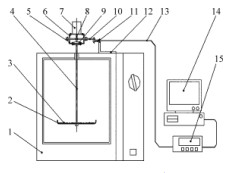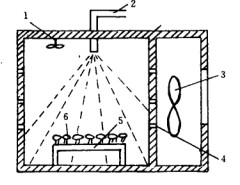Modeling and Simulation of Potato Microwave Drying Dynamics
Abstract: Using the self-made microwave hot air coupling drying system, the temperature and water content of potato diced under different microwave powers (600, 900, 1 200 and 1500 W) were tested to obtain the microwave drying curve, drying rate curve and drying of potato. The optimal microwave power density was established to establish a microwave drying kinetic model and an effective moisture diffusion model for the potato.

The effective water diffusion coefficient model of potato diced was substituted into COMSOL Multiphysics software to establish a three-field coupling model of electromagnetic field, solid heat transfer and dilute matter transfer. The results showed that the microwave drying rate of potato diced entered after the acceleration period of 270 s. During the deceleration period, the optimal microwave power density of the microwave drying equipment is 6 W/g. The drying model can be described by the Page equation. The effective moisture diffusion coefficient of the microwave drying of the potato is 4.35×10–9~9.02×10–9 m2/s. .
Key words: potato microwave drying; kinetic model; COMSOL simulation
Microwave drying has the advantages of fast drying rate, high efficiency, low energy consumption, etc., and is widely used in the food industry. Yi Li et al. established a microwave hot air drying kinetic model and effective water diffusion coefficient to predict the drying time of papaya under different conditions. Wei Lingjun studied the heat of chicken at –5~95 °C and frequency of 2 450 MHz. Physical and dielectric properties.
The results show that the speed of the ideal turntable is 7.5 r/min in the microwave heating process of household microwave oven. Tao Man et al studied the microwave drying characteristics of peony seeds, and used the drying rate, shelling rate and ripening rate of peony as evaluation indexes. The best method for obtaining dried peony seeds by microwave is the drying time of 20 s, the intermittent time of 60 s, and the thickness of the material layer is 2 layers.
In order to more intuitively understand the dry state of materials during microwave drying, some scholars used different simulation software to simulate the process of microwave heating and drying food. Pitchai et al. used Quickwave in FDTD to simulate the process of microwave heating food. The temperature distribution was similar to the material drying test. Liu et al. used FEMAP and PHOTO–Series software to simulate the process of heating food in microwave oven and compared it with the test results. PEDREÑO–MOLINA et al. discussed the heating of different load positions by thermal imaging method; Zhang Ke et al. used COMSOL Multiphysics software to simulate the process of microwave heating food package, and established the electromagnetic-thermal conduction two-way coupling model of food dielectric properties with time. And carried out experimental verification.
These studies either established mathematical models under microwave heating or dual-field coupling of electromagnetic fields to solid heat transfer fields using simulation software alone. Since it is difficult to monitor the dry state (ie, temperature and moisture content) of the material by means of testing in a microwave environment, it is necessary to simulate the dry state of the material under microwave heating. The author established the microwave drying dynamics model and the effective water diffusion coefficient model of potato. The three-field coupling model of electromagnetic field, solid heat transfer and dilute matter transfer was established by using COMSOL Multiphysics as the simulation software to simulate the moisture content of potato dregs during microwave heating. And the temperature with the change of microwave power and heating time, and the test was verified.